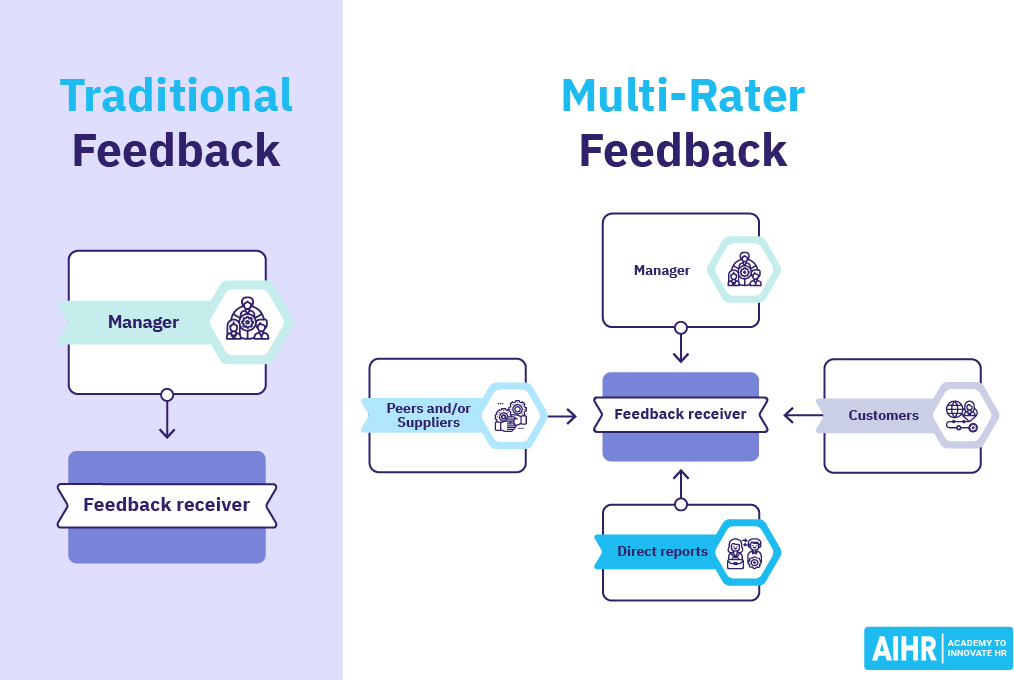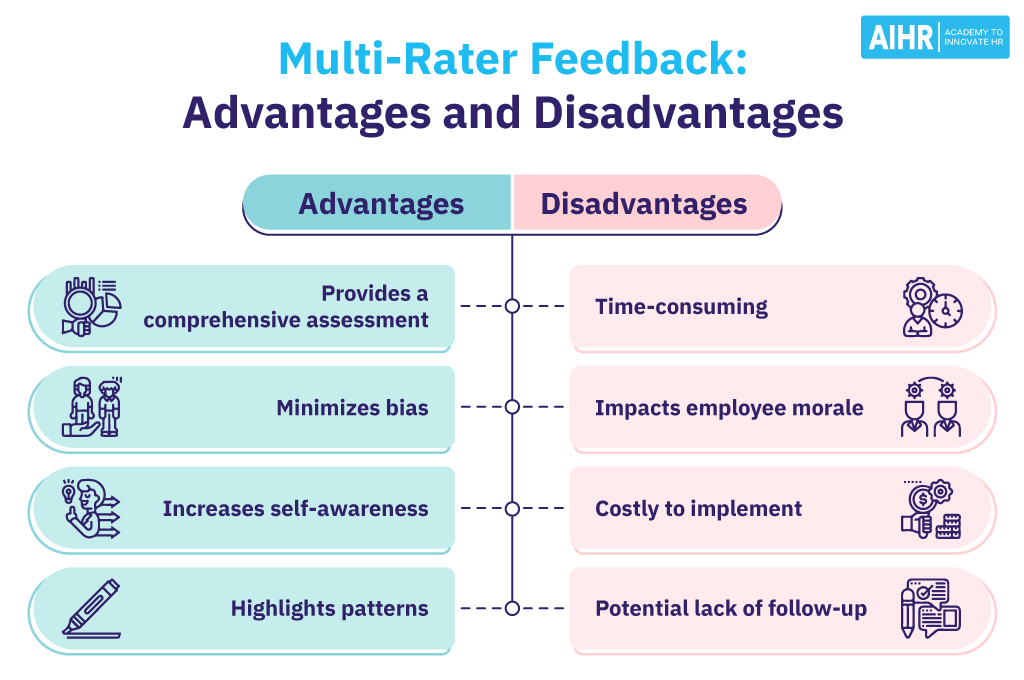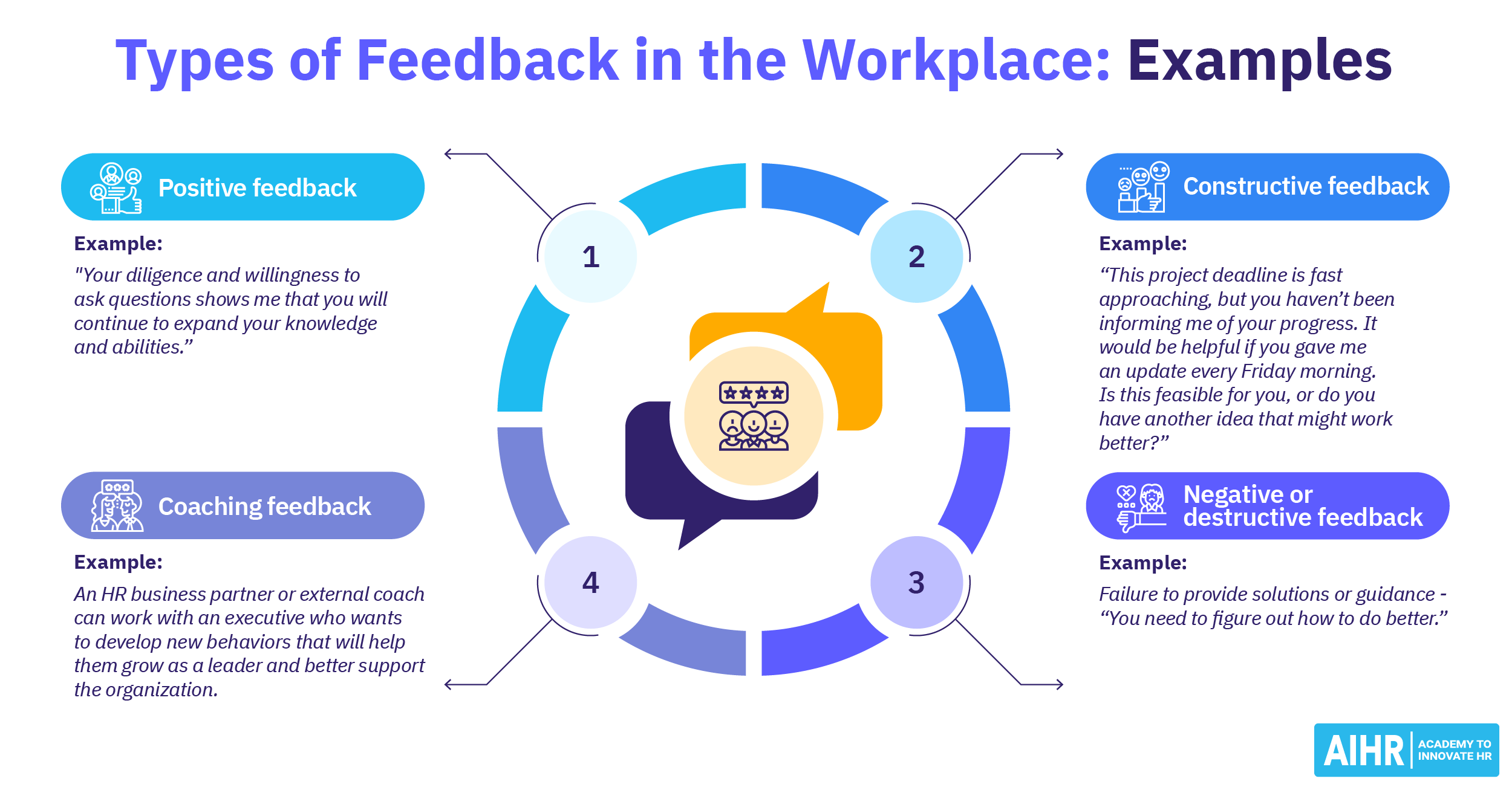Multi Rater Feedback
What is multi-rater feedback?
Multi-rater feedback is a performance appraisal method that gathers feedback from multiple sources within an organization. In a multi-rater feedback system, managers, colleagues, direct reports, and clients/customers can provide feedback on an individual employee’s job performance.
The most common form of multi-rater feedback is the 360-degree feedback, but there are other examples, such as 180-degree feedback, 720-degree feedback, and peer reviews. The overall purpose of this feedback system is to provide a comprehensive view of an employee’s performance, skills, behavior, and interactions within the workplace.
Why is multi-rater feedback important?
Receiving feedback from multiple sources is crucial to ensure fairness and get a comprehensive view of an employee’s performance. In some traditional performance management appraisal systems, employees only receive insights from their manager (and sometimes only annually), which may only provide a partial view of their performance.
However, multi-rater feedback offers a fuller picture of an employee’s strengths, areas for improvement, potential for career development, and overall job performance. This multi-faceted approach to performance appraisal can help avoid bias or discrimination.

Multi-rater feedback examples
There are various forms of multi-rater feedback. Here are some of the most common examples:
- 360-degree feedback: This model gathers evaluations from an employee’s manager, colleagues, direct reports, upper management, and even clients and customers. The employee also has the opportunity to self-evaluate their performance.
- 180-degree feedback: This performance appraisal method is a simplified version of 360-degree feedback, as it typically focuses on two core evaluations from the employee and manager. An employee evaluates their strengths and areas for improvement. The second assessment comes from their manager or supervisor.
- 720-degree feedback: An advanced feedback method that builds on the 360-degree feedback process. It starts with the usual cycle of gathering input from all directions and then adds a follow-up phase where the individual reviews the initial feedback, creates a development plan, and implements it. Finally, feedback is collected again to assess progress and the action’s impact.
- Peer reviews: Feedback comes solely from co-workers who work closely with an employee. It often provides insights into interpersonal skills, teamwork, and collaboration skills.
- Upward appraisal: Direct reports evaluate their manager’s performance, including their leadership, interpersonal, and communication skills. The aim is to offer a balanced overview of a manager’s effectiveness.
- Board evaluation: Members of a board provide feedback on a CEO or senior leader’s performance, especially their ability to lead the organization effectively.
HR tip
Whichever multi-rater feedback system you use, do not use it as the only basis for performance evaluations or promotions. Ensure you balance it with other performance metrics, like customer satisfaction, and key performance indicators, such as productivity and meeting sales targets.
Multi-rater feedback advantages and disadvantages
Benefits of multi-rater feedback
- Comprehensive assessment: By collecting feedback from multiple sources, the evaluation provides a more comprehensive view of an employee’s performance.
- Minimizing bias: Since this feedback is gathered from multiple sources, it can reduce biases that might arise from single-source feedback and can offer a rounded view of how the individual interacts with different stakeholders.
- Increased self-awareness: Receiving feedback from multiple angles can enhance an individual’s understanding of how others perceive them. This can motivate employees to develop their skills and address areas of weakness.
- Highlights patterns: Multi-source evaluations may make it easier to spot performance patterns, especially when multiple sources report similar areas about an employee’s performance (both positive and negative).
Limitations of multi-rater feedback
- Time-consuming process: Conducting feedback using this system can be more complex than traditional single-rater methods. Organizing input from multiple sources can be time-consuming and requires significant administrative effort to coordinate.
- Impact on employee morale: If not managed carefully, this feedback can lead to feelings of embarrassment or resentment, especially if the feedback is unexpectedly critical or presented in a non-constructive manner.
- Costly to implement: Multi-rater feedback systems can be expensive, depending on the type of software, HR training, and time involved in performance analysis and reporting.
- Lack of follow-up: The effectiveness of multi-rater feedback can be limited without a structured follow-up process. It is essential for individuals to receive guidance on creating actionable plans based on the input. Without such support, meaningful improvements may not occur.

Implementing a multi-rater feedback system: Best practices for HR
Here is a step-by-step guide you can use to implement a multi-rater feedback system successfully:
- Step 1: Clearly outline goals and objectives: For each multi-rater feedback you use (e.g., 180-degree feedback, peer review, etc.), clearly define the main aims to be achieved. For example, is the focus more on employee development, leadership potential, or improving collaboration?
- Step 2: Choose the right multi-rater feedback method: Select the most valid multi-rater feedback system that aligns with the above key goals and objectives and suits the individual employee’s role or professional development potential.
- Step 3: Identify the most relevant stakeholders: Determine who the best stakeholders are to provide input on an employee’s performance, particularly those with direct experience with the employee and who are committed to providing feedback.
- Step 4: Train relevant HR professionals and participants: Ensure both HR and relevant participants receive training on the selected multi-rater feedback system before full implementation. This will also help identify any areas needing improvement before the evaluations.
- Step 5: Provide support for development: After the feedback, provide support to employees through coaching, training, or development plans based on the feedback results. This shows a commitment to using the feedback constructively and helps in personal and professional growth.
- Step 6: Cultural considerations: Adapt the feedback system to fit the organization’s cultural context. What works in one cultural setting might not work in another, especially in global organizations. Cultural sensitivity can affect how feedback is given, received, and perceived.
HR tip
Regularly monitor your chosen multi-rater feedback system after each evaluation process. Gather feedback from participants and other key stakeholders to make any necessary adjustments.







